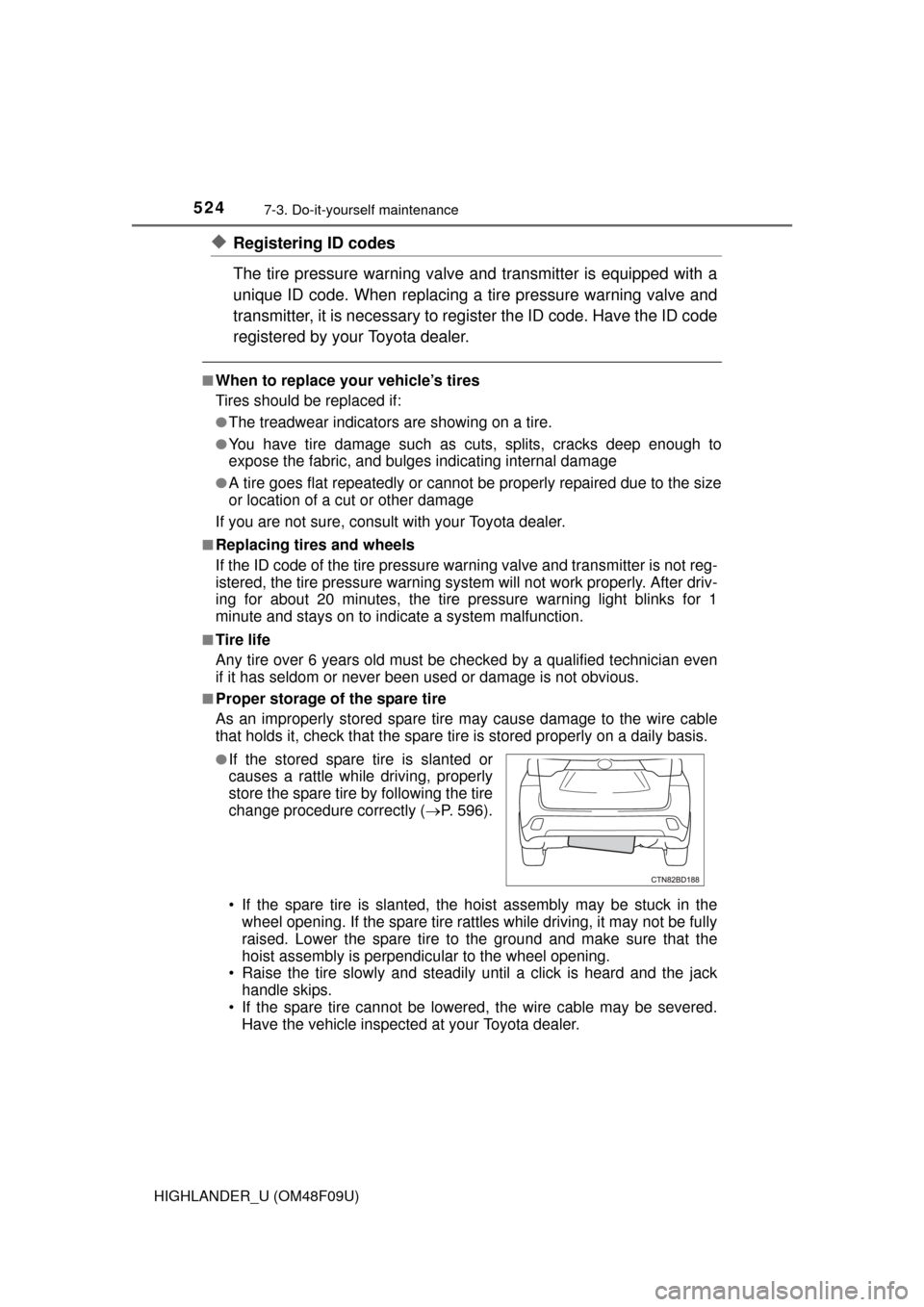Page 331 of 716

3314-6. Driving tips
4
Driving
HIGHLANDER_U (OM48F09U)
Your vehicle is not designed to be driven off-road. However, in the
event that off-road driving cannot be avoided, please observe the fol-
lowing precautions to help avoid the areas prohibited to vehicles.
● Drive your vehicle only in areas where off-road vehicles are permit-
ted to travel.
● Respect private property. Get owner’s permission before entering
private property.
● Do not enter areas that are clos ed. Honor gates, barriers and signs
that restrict travel.
● Stay on established roads. When conditions are wet, driving tech-
niques should be changed or trav el delayed to prevent damage to
roads.
● Avoid driving on very steep, sli ppery roads and other surfaces,
such as sand, where the tires are li able to lose traction. Your vehi-
cle may not perform as well as conventional AWD on-road vehicles
on these surfaces.
■ Additional information for off-road driving
For owners in U.S. mainland, Hawaii and Puerto Rico:
To obtain additional information pertaini ng to driving your vehicle off-road,
consult the following organizations.
● State and Local Parks and Recreation Departments
● State Motor Vehicle Bureau
● Recreational Vehicle Clubs
● U.S. Forest Service and Bureau of Land Management
Off-road driving
Page 487 of 716
487
7Maintenance and care
HIGHLANDER_U (OM48F09U)7-1. Maintenance and care
Cleaning and protecting the vehicle exterior .......... 488
Cleaning and protecting the vehicle interior ........... 492
7-2. Maintenance Maintenance requirements ................... 495
General maintenance........ 498
Emission inspection and maintenance (I/M)
programs ......................... 502
7-3. Do-it-yourself maintenance
Do-it-yourself service precautions ..................... 503
Hood ................................. 505
Positioning a floor jack ...... 507
Engine compartment ......... 508
Tires .................................. 520
Tire inflation pressure ....... 531
Wheels .............................. 534
Air conditioning filter.......... 536
Wireless remote control/ electronic key battery ...... 538
Checking and replacing fuses ................ 541
Light bulbs......................... 545
Page 501 of 716
5017-2. Maintenance
7
Maintenance and care
HIGHLANDER_U (OM48F09U)
Vehicle exterior
ItemsCheck points
Doors• Do the doors operate smoothly?
Engine hood• Does the engine hood lock system work prop-erly?
Fluid leaks• There should not be any signs of fluid leakageafter the vehicle has been parked.
Tires
• Is the tire inflation pressure correct?
• The tires should not be damaged or exces-sively worn.
• Have the tires been rotated according to the
maintenance schedule?
• The wheel nuts should not be loose.
Windshield wipers/rear
window wiper
• The wiper blades should not show any signs
of cracking, splitting, wear, contamination or
deformation.
• The wiper blades should clear the windshield/
rear window without streaking or skipping.
WARNING
■If the engine is running
Turn the engine off and ensure that there is adequate ventilation before per-
forming maintenance checks.
Page 520 of 716
5207-3. Do-it-yourself maintenance
HIGHLANDER_U (OM48F09U)
Check if the treadwear indicators are showing on the tires. Also check
the tires for uneven wear, such as excessive wear on one side of the
tread.
Check the spare tire condition and pressure if not rotated.
New tread
Worn tread
Treadwear indicator
The location of treadwear indicators is shown by a “TWI” or “” mark,
etc., molded into the sidewall of each tire.
Replace the tires if the treadwear indicators are showing on a tire.
Tires
Replace or rotate tires in acco rdance with maintenance sched-
ules and treadwear.
Checking tires
1
2
3
Page 521 of 716
5217-3. Do-it-yourself maintenance
7
Maintenance and care
HIGHLANDER_U (OM48F09U)
Rotate the tires in the order shown.
Do not fail to initialize the tire pressure warning system after tire rota-
tion.
To equalize tire wear and extend ti re life, Toyota recommends that tire
rotation is carried out at the sa me interval as tire inspection.
Tire rotation
Vehicles with compact spare
tireVehicles with full-size spare
tire
FrontFront
Page 522 of 716

5227-3. Do-it-yourself maintenance
HIGHLANDER_U (OM48F09U)
Your vehicle is equipped with a tire pressure warning system that uses
tire pressure warning valves and tr ansmitters to detect low tire infla-
tion pressure before serious problems arise.
If the tire pressure drops below a predetermined level, the driver is
warned by a warning light. ( P. 571)
◆Installing tire pressure warning valves and transmitters
When replacing tires or wheels, tire pressure warning valves and
transmitters must also be installed.
When new tire pressure warning valves and transmitters are
installed, new ID codes must be registered in the tire pressure
warning computer and the tire pr essure warning system must be
initialized. Have tire pressure warning valve and transmitter ID
codes registered by your Toyota dealer. ( P. 524)
◆Initializing the tire pressure warning system
■The tire pressure warning system must be initialized in the fol-
lowing circumstances:
● When the tire inflation pressure is changed such as when chang-
ing traveling speed or load weight.
When the tire pressure warning system is initialized, the current tire
inflation pressure is set as the benchmark pressure.
Tire pressure warning system
Page 524 of 716

5247-3. Do-it-yourself maintenance
HIGHLANDER_U (OM48F09U)
◆Registering ID codes
The tire pressure warning valve and transmitter is equipped with a
unique ID code. When replacing a tire pressure warning valve and
transmitter, it is necessary to register the ID code. Have the ID code
registered by your Toyota dealer.
■When to replace your vehicle’s tires
Tires should be replaced if:
●The treadwear indicators are showing on a tire.
●You have tire damage such as cuts, splits, cracks deep enough to
expose the fabric, and bulges indicating internal damage
●A tire goes flat repeatedly or cannot be properly repaired due to the size
or location of a cut or other damage
If you are not sure, consult with your Toyota dealer.
■Replacing tires and wheels
If the ID code of the tire pressure warning valve and transmitter is not reg-
istered, the tire pressure warning system will not work properly. After driv-
ing for about 20 minutes, the tire pressure warning light blinks for 1
minute and stays on to indicate a system malfunction.
■Tire life
Any tire over 6 years old must be checked by a qualified technician even
if it has seldom or never been used or damage is not obvious.
■Proper storage of the spare tire
As an improperly stored spare tire may cause damage to the wire cable
that holds it, check that the spare tire is stored properly on a daily basis.
• If the spare tire is slanted, the ho ist assembly may be stuck in the
wheel opening. If the spare tire rattles while driving, it may not be fully
raised. Lower the spare tire to the ground and make sure that the
hoist assembly is perpendic ular to the wheel opening.
• Raise the tire slowly and steadily until a click is heard and the jack
handle skips.
• If the spare tire cannot be lowered, the wire cable may be severed. Have the vehicle inspected at your Toyota dealer.
●If the stored spare tire is slanted or
causes a rattle while driving, properly
store the spare tire by following the tire
change procedure correctly ( P. 596).
Page 525 of 716

5257-3. Do-it-yourself maintenance
7
Maintenance and care
HIGHLANDER_U (OM48F09U)■
Routine tire inflation pressure checks
The tire pressure warning system does not replace routine tire inflation
pressure checks. Make sure to check tire inflation pressure as part of
your routine of daily vehicle checks.
■Maximum load of tire
Check that the number given by dividing the maximum load by 1.10 of the
replacement tire is greater than 1/
2 of the Gross Axle Weight Ratings
(GAWR) of either the front axle or the rear axle, whichever is greater.
■Tire types
●Summer tires
Summer tires are high-speed performance tires best suited to highway
driving under dry conditions. Since summer tires do not have the same
traction performance as snow tires, summer tires are inadequate for
driving on snow-covered or icy ro ads. For driving on snow-covered
roads or icy roads, the use of snow tires is recommended. When install-
ing snow tires, be sure to replace all four tires.
●All season tires
All season tires are designed to provide better traction in snow and to
be adequate for driving in most winter conditions as well as for use
year-round. All season tires, however, do not have adequate traction
performance compared with snow tires in heavy or loose snow. Also, all
season tires fall short in acceleration and handling performance com-
pared with summer tires in highway driving.
●Snow tires
For driving on snow-covered roads or icy roads, we recommend using
snow tires. If you need snow tires, select tires of the same size, con-
struction and load capacity as the or iginally installed tires. Since your
vehicle has radial tires as original equipment, make sure your snow
tires also have radial construction. Do not install studded tires without
first checking local regulations fo r possible restrictions. Snow tires
should be installed on all wheels. ( P. 326)
■If the tread on snow tires wears down below 0.16 in. (4 mm)
The effectiveness of the tire s as snow tires is lost.
For the GAWR, see the Certification
Label. For the maximum load of the tire,
see the load limit at maximum cold tire
inflation pressure mentioned on the
sidewall of the tire. (
P. 655)